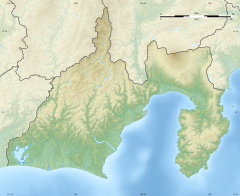Gyokusen-ji
| Gyokusen-ji | |
|---|---|
玉泉寺 | |
Sōtō Zen | |
| Location | |
| Location | Kakizaki 31-6, Shimoda-shi, Shizuoka |
| Country | |
| Geographic coordinates | 34°40′33″N 138°57′45″E / 34.67587°N 138.962417°E |
| Architecture | |
| Completed | Tenshō period (1573–1592) |
| Website | |
| gyokusenji | |
Gyokusen-ji (玉泉寺) is a Buddhist temple located in the city of Shimoda, Shizuoka Prefecture, Japan. It is noteworthy in that it served as the first American consulate in Japan. The temple and its grounds were designated as a National Historic Site of Japan in 1951.[1]
History
The exact date of the foundation of Gyokusen-ji is uncertain, but temple records indicate that it was originally a
Visit by Admiral Putyatin
Gyokusen-ji was selected by officials of the Tokugawa shogunate to host Imperial Russian admiral
and one from the Askold) who died while at Shimoda are located at the temple.First US consulate in Japan
Shortly after the Russian delegation departed, Gyokusen-ji was again commandeered by the government. After the
The temple has opened the Townsend Harris Museum, with documents,
Foreign cemetery

Five Americans and three Russians who died in Shimoda in the 1850s are buried in the temple cemetery. The five Americans buried at Gyokusen-ji are recorded as:[3]
- Robert Williams,
- G.W. Parish, USN sailor who died in a fall from rigging while serving on the USS Powhatan (d. 5 May 1854, aged 24)
- Jas. Hamilton, USN Assistant Surgeon on the USS Susquehanna (d. 6 September 1854, aged 38)
- John D. Storm, USN fireman serving on the USS Powhatan (b. Schoharie County, New York, d. 2 February 1855, aged 27)
- Alexander Doonan, US Marine serving on the USS Mississippi (d. 31 July 1858)
Other memorials

Harris remained in residence at the temple for two years and ten months. During his stay, Harris demanded that the Japanese provide him with both milk and beef. Gyokusen-ji today has a monument decorated with the image of a cow, which the temple claims to mark the site where the first cow to be slaughtered in Japan for human consumption was killed. Its English language sign reads:
"This monument, erected in 1931 by the butchers of Tokyo, marks the spot where the first cow in Japan was slaughtered for human consumption. (Eaten by Harris and Heusken)".
Other memorials include a commemoration of the temple as the birthplace of Japanese milk production, and another commemorating the visit of President Jimmy Carter in 1979.
See also
References
- ^ "玉泉寺" (in Japanese). Agency for Cultural Affairs. Retrieved August 20, 2020.
- ^ Ilyishev, A.V.; Saplin V.I. (2004). "The Mission of E.V. Putyatin. The 150th Anniversary of the Establishment of Russo-Japanese Relations". Archived from the original on July 4, 2007. Retrieved 2009-11-15.
- ^ Dienst, G.E. (16 June 1894). "Letter: The U.S. Marine Tombs at Kakisaki". The Japan Weekly Mail.
- ISBN 978-0786437962.
- ^ Cary, Otis (1909). A History of Christianity in Japan. New York: Fleming H. Revell Company. p. 32.
- ISBN 978-0824812584.
Bibliography
- Statler, Oliver. Shimoda Story. University of Hawaii Press (1986) ISBN 0824810597
- Van Zandt, Howard F. Pioneer American Merchants in Japan. Lotus Press (1981). ASIN B001MSYALO


